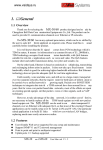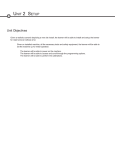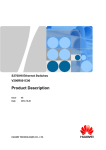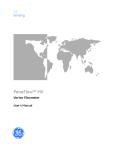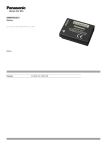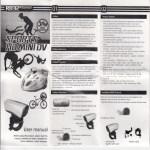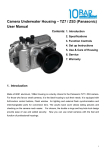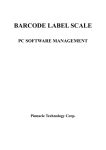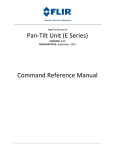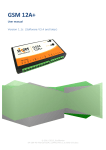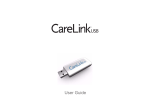Download IjiEm I l
Transcript
US 20080198787A1
(19) United States
(12) Patent Application Publication (10) Pub. No.: US 2008/0198787 A1
NGUYEN
(54)
(43) Pub. Date:
Aug. 21, 2008
MOBILE DATA OBJECT TRANSMISSION
OVER WIRELESS COMMUNICATION
NETWORKS USING UDP AND TWO LEVEL
(51)
Publication Classi?cation
Int- Cl
H04B 7/14
(200601)
PROTOCOL
(52)
US. Cl. ...................................................... .. 370/315
(75) Inventor:
Van NGUYEN, Alpharetta, GA
(57)
(Us)
Systems and methods for data communication between mul
ABSTRACT
tiple computing devices, comprising: transmitting data
Correspondence Address:
through a selectable communication medium by constructing
MORRIS MANNING MARTIN LLP
a frame for data, dividing the frame into TXU packets, divid
3343 PEACHTREE ROAD, NE, 1600 ATLANTA
ing each TXU packet into UDP segments; grouping the UDP
FINANCIAL CENTER
segments into Windows; and sending each WindoW to a sec
ATLANTA, GA 30326
ond computing device; receiving the data at the second com
(73) Assignee;
AGENTEK, INC" Alpharenaa GA
puting device comprising receiving UDP segments, assem
bling UDP segments to recreate TXU packets, sending an
(Us)
ACK message for the ?rst UDP segment of each non-?nal
WindoW and for the last UDP segment of a TXU packet of a
(21) APPL No,
11/931,799
(22)
Oct 31, 2007
F 11 e d:
?nal WindoW to the ?rst computing device, and sending a
NAK message, specifying missing segments; the ?rst com
puting device, upon receiving the ACK message, sending the
next WindoW, and upon receiving a NAK message, retrans
.
.
mittin missin UDP se ments; and at the second com utin
Related U's' Apphcatlon Data
deviceg, upon rgeceiving g ?nal TXU packet for a framg, recg
(60) Provisional application NO_ 60/890,109, ?led on Feb
15, 2007.
112
114
reating the frame by reassembling the TXU packets. Probe
messages are sent for missing ACKs and NAKs.
|
l
GPRS I CDMA
% Sewer
ES {
Mobile
Intensive Intensive |
Mobile
Server l
I_lntens|ve lntens|ve|
Mobile Q“a
Device
102
End User
Applications
8-9,
Confirmed
Agent120
Agent 120
t3
IjiEm
l
|
e- -,
Delivery Order Entry 8 stem l
Field Service Order En ry
I
|
A
1268
LC
_ Eek! ier_vlc_e
End User
Application Data
132
ggr'vice Histo
User's Manua
gccounl Info
chedule
r—' —\
lIlIIllIllIllIllIllIllIl
\
12%
1
A
\
lIllIllIlElEllIllIllIl
UDP segment
Sewer
Intensive I
I
1266
r
A
\
EllIllIlUlIlElElEl
l
l
L-
Operationl
13s
|
-----J
ligjiegrl‘ijceMHisto
Aigoini an“
Schedule
Automatic mobile data object transmission over wireless
communication networks using UDP and TXP2
Patent Application Publication
Aug. 21, 2008 Sheet 3 0f 10
Q8\\
mEmvEwr
mworzcumow
ll.|lI1
“39gXV.o02wm_n. £888
xN0o6w.
E.@
EM® E
_:.é im w Nomv6<
US 2008/0198787 A1
_
xm0o<m
:EoFmowcgm w
.u:wmN6CQon0c_E2X-.wmIPoéiCM
_
Irl l
I
slsl
_
.E
Patent Application Publication
Aug. 21, 2008 Sheet 4 0f 10
/
US 2008/0198787 A1
400
Sender constructs frame
402
Sender divides frame into TXU packets
404
Sender divides TXU packets into UDP segments 406
l
Sender assembles groups of UDP segments in windows
408
Sender sends windows to receiver
410
Receiver processes windows
412
l
l
414
to recreate frame
416
Receiver assembles the UDP segments
to recreate TXU packets
Receiver assembles the TXU packets
FIG. 4 - TXP2 High Level Algorithm
Patent Application Publication
Aug. 21, 2008 Sheet 5 0f 10
€I®
Construct Frame
for Agent Data
US 2008/0198787 A1
/— 500
502
V
Divide Frame
into TXU Packets
504
i
Divide Each TXU Packet
into UDP Segments
506
V
Group UDP Segments
into Windows
508
Send Next Available
Window to Receiver
510
i
Receive Message
from Receiver
NO
512
Identify Missing
UDP Segment(s) 518
V
Group Missing
UDP Segment(s)
into Retransmit
Window
520
7
Send Retransmit
Window
to Receiver
522
|__
4
@i»
FIG. 5A - TXP2 Sender Algorithm
Patent Application Publication
Aug. 21, 2008 Sheet 6 0f 10
US 2008/0198787 A1
>
[
530
Receive UDP Segment
532
First
Yes
UDP Segment?
534
Creat TXU Packet
536
No
Add UDP Segment
to TXU Packet
538
First
U_DP Se ment
in Win ow?
540
Final
UDP Segment
Yes
of TXU Packet?
546
Send ACK
544
UDP Segment(s)?
All Se ments
of TX Packet
Received?
554
No
Send ACK
556
ldent?y Missing
UDP Segment(s)
550
Final Segment
Yes
of Final TXU Packet?
558
Send NAK
552
Recreate Frame
560
FIG. 5B - TXP2 Receiver Algorithm
Patent Application Publication
Aug. 21, 2008 Sheet 7 0f 10
US 2008/0198787 A1
/ 600
’ Server
Mobile %
Device
134
.5
102
_
_
_
_
_
_
_
I TXP2 Protocol
_
—
__
l
|
|
I
|
|
l
|
l
'
|
|
'
74K
l
|
Agent ‘I20
I
|
l
|
I'_'______—_—_—I
I
77$
:
Agent 120'
Virtual Space 604'
|
Virtual Space 604
:
:
|
'
|
Agent
:
:
120
|
l
I
|
Object Communication
I
|
Object Communication
|
I
Protocol
I
l
I
Protocol
I
l
|
I
I
|
TXM6°8a
'
606a
TXU
Frame
124
|
:
' :1
1:: I
l
6108
I TXU Packets 126
|
TXMeoso
:
TXU
60%
l
|
l
61%
I
l
| _______ _ _ @2_|
l
L
602' |
r—*'?
lIllIlEllIllIllIllIlEl
UDP
UDP segments 128
Protocol
P_
612a
UDP
Protocol
11
I_____7/__'p?_ _81
<.
'
'>
J
_.(,)
l
I
|
612D
J >—
T
Virtual Session
116
FIG. 6 - TXP2 Communications Protocol
Patent Application Publication
Aug. 21, 2008 Sheet 8 0f 10
own
8:3? toQwcmF
wmovcn.
g»
NNN
US 2008/0198787 A1
mm“
652 {3089642
A
NlXP
mom
NON_wO
won
o5
cozm=g< coz?mwi co?wm tonwcm.
NE
in
{0362
2L
EL
Evm:a
E2 51
Patent Application Publication
Aug. 21, 2008 Sheet 9 0f 10
US 2008/0198787 A1
682 9
No_n2w5:m35
0%\\
“nv8w2E_m5o0O3<2w v“nmE_w5<o3mzQEw
Now#2
2@56 20m
.wmnvoIEi
Patent Application Publication
Aug. 21, 2008 Sheet 10 0f 10
US 2008/0198787 A1
hvom
052E35w
Ewm<
NnUC. 602 i
‘£8 ”.0m62m
W
#2o
8m4/.8
owow u"\4‘0“now?
£2_8%5E5
.7w:E02E22(0. MOOo\)
n
_
_
‘1.
n"8@3OM»205o_mu:Ea>w
_
_
/Mw:co_?wmst>
n
“
E
//
\m
n“wNow8 mm“E33woEmLS<m_wao:SN?En$8> .QEa
_
_
_
#88M
F\
“?x
£8“n
<
Em
a_
.
{Nil:0}
_EXP$5| IIOI|l l “
Aug. 21, 2008
US 2008/0198787 A1
MOBILE DATA OBJECT TRANSMISSION
OVER WIRELESS COMMUNICATION
NETWORKS USING UDP AND TWO LEVEL
PROTOCOL
[0006]
Error correction, interleaving, and retransmissions
are used at loWer protocol layers to reduce transmission errors
at the upper protocol layers. In many Wireless netWorks, the
data link layer performs error recovery according to some
automatic repeat request (ARQ) protocol. ARQ is an error
CROSS-REFERENCE TO RELATED
APPLICATIONS
[0001] This application claims the bene?t under 35 U.S.C.
§ ll9(e) of US. Provisional Patent Application Ser. No.
60/890,109, entitled “Mobile Data Object Transmission Over
Wireless Communication Networks Using UDP and TWo
Level Protocol,” ?led Feb. 15, 2007, Which is incorporated
herein by reference as if set forth herein in its entirety.
TECHNICAL FIELD
[0002]
The present invention generally relates to a data
communication system. More particularly, the present inven
tion relates to a mobile data object communication system
With at least a portion of the communication typically con
ducted over Wireless communication netWorks.
BACKGROUND
[0003]
Wireless netWorks such as GPRS (General Packet
Radio Service), CDMA (Code Division Multiple Access),
GSM (Global System for Mobile communications), and other
similar Wireless netWorks are becoming more Widely
deployed and are increasingly more often used to access
services on the Internet. Traditionally, Transmission Control
Protocol (TCP) is Widely used in communications over Wire
less netWorks. TCP technology has been very successful pro
viding services to users of ?xed, Wired netWorks. For Wireless
control method for data transmission Which makes use of
acknoWledgments and timeouts to achieve reliable data trans
mission. An acknoWledgment is a message sent by the
receiver to the transmitter to indicate that it has correctly
received a data frame. Usually, if the transmitter does not
receive the acknoWledgment before the timeout occurs (i.e.
Within a predetermined amount of time after sending the data
frame), it retransmits the frame until it is either correctly
received or the error persists beyond a predetermined number
of retransmissions.
[0007] If the maximum number of retransmissions (or the
maximum time spent retransmitting a frame) is limited to tens
of retransmissions, then the ARQ protocol is de?ned as highly
persistent or highly reliable. A loW persistent or partially
reliableARQ protocol, on the other hand, retransmits a frame
2-5 times before it gives up and transmits the next frame
instead.
[0008]
In comparison to ?xed netWorks, Wireless netWorks
may seem to have very similar properties. HoWever, When the
radio quality is loW, data loss may occur over a Wireless link
due to transmission errors. In cellular netWorks, handovers
also cause data loss. Data loss due to handover occurs par
ticularly often if a user moves at high speed from one Wireless
node to another. Handover typically results in delay and in
many cases, data loss. Delay is introduced since it takes time
for ?xed netWorks. TCP Was designed for netWorks With
to forWard data to a neW base station and to perform the
handover procedure. Data loss occurs if an old base station
?ushes its buffer instead of forWarding data to the neW base
station. The handover is not transparent to TCP, since recov
ery of lost data introduces delay. Wireless netWorks have a
Wired links and stationary hosts. In these Wired netWorks, data
long delay compared to Wired netWorks, since transmission
netWorks, TCP performance is reportedly much loWer than
is lost primarily due to congestion. TCP typically interprets
over a radio interface is sloWer than transmission over a Wired
data loss as congestion in the network, and for data loss TCP
medium. Additional delay may be introduced due to process
ing on a physical layer and on a data link layer. In cellular
sloWs the transmission rate in an attempt to reduce the con
gestion. In a Wireless netWork, one can not assume that data
losses are caused by congestion. Instead, data loss is more
often caused by the relative loW quality of the Wireless link.
Terminal mobility, Which is supported by many Wireless net
Works, may also result in data loss. If data is lost for some
reason other than congestion, then performance is unneces
sarily degraded as TCP reduces its transmission rate in
response to the loss. Therefore, one reason for performance
netWorks, processing on the physical layer (error correction
and interleaving) is extensive and therefore produces a rela
tively long delay. On the data link layer, delay is increased by
the use of MAC and ARQ. This delay is variable, since it
depends on other users’ activity (MAC) and on the radio
conditions (ARQ). The delay variation experienced by TCP
may become very large if the link layer ARQ is highly per
sistent as in GSM, GPRS and CDMA.
degradation is that TCP Works less e?iciently in Wireless
[0009]
netWorks.
less netWorks than in ?xed netWorks. TCP is unable to distin
[0004]
guish problems that typically occur in Wireless netWorks from
the problems caused by netWork congestion. Although con
A Wireless netWork comprises a plurality of mobile
stations and a plurality of intermediate nodes. The interme
diate nodes are required to connect the Wireless communica
tion netWork to Wired communication netWorks. For
example, an inter-Working unit is used to connect a cellular
telephony netWork to a Wired netWork.
The performance of TCP is generally loWer in Wire
gestion control algorithms in TCP may be used to reduce the
effects of the congestion, the congestion control algorithms
the radio quality may vary considerably over time, the band
are based on the assumptions that data is lost mainly due to
congestion and that data loss due to transmission errors is
rare. HoWever, this assumption is no longer true for a Wireless
communication netWork. TCP segments may be lost if the
Width is usually loWer, and transmission errors occur more
radio conditions are poor and the link layer protocol provides
[0005]
Wireless links are not as robust as Wired links, since
frequently. Sending signals over an omni-directional radio
a loW reliability. After some retransmission attempts the link
based medium gives rise to more errors than in a guided
medium such as ?ber or coax. Signal strength Weakens With
the distance betWeen a mobile device and a mobile station.
layer protocol gives up and leaves further error recovery to
TCP. Handover events may also lead to data loss. A Whole
WindoW of data may be lost due to handover. Data loss due to
Additionally, radio Waves bounce off objects, causing inter
ference and multi-path effects.
event folloWed by sloW start or three dupacks folloWed by fast
an unreliable link layer or a handover may cause a timeout
Aug. 21, 2008
US 2008/0198787 A1
retransmit and fast recovery. In either case, the congestion
control action taken by TCP is unnecessary. Directly after the
mination that at least one UDP segment Was not received,
sending a NAK message to the remote electronic device,
loss event, the radio quality may become high again, and after
specifying the segment number for each missing segment;
handover data may be transmitted Without problems to the
and upon determination that a ?nal UDP segment for the TXU
neW mobile station.
packet has been received, sending an ACK message to the
remote electronic device; at the remote electronic device,
[0010]
TCP may also misinterpret a sudden increase in the
round trip time as data loss. If the delay is long enough for the
retransmission timer to expire before an acknowledgment is
received, then TCP misinterprets the delay as an indication of
data loss due to congestion. The delayed data is unnecessarily
upon receiving the ACK message from the server, if a next
WindoW remains to be sent, sending the next WindoW from the
remote electronic device to the server; at the remote elec
tronic device, upon receipt of the NAK message: retransmit
ting missing UDP segments to the server, comprising: iden
tifying missing UDP segments according to the NAK
retransmitted and TCP enters sloW start. A highly variable
round trip time can also lead to a large retransmission timeout
value (RTO), since the RTO is based both on estimates of the
round trip time and on variations in the round trip time. If the
RTO is large, then TCP reacts sloWly to data loss. Variations
in the round trip time can be caused by link level retransmis
sions of a Wireless link. If the link layer frames that contain a
TCP segment must be retransmitted because of a poor radio
received, recreating the frame by reassembling the plurality
environment, then the Whole segment is delayed. Round trip
of TXU packets.
time variations may also be caused by handover or competing
tra?ic. Queuing in routers, base stations, and other interme
diate nodes may also lead to a long round trip time. A long
round trip time may cause loW throughput and underutiliZa
tion of the netWork, since it takes a number of round trip times
before the congestion WindoW reaches the capacity of the
netWork. TCP performance is degraded, especially for short
lived ?oWs, Which transmits a small amount of data.
[0011]
Therefore, it is apparent that a heretofore unad
dressed need exists in the art to address the aforementioned
de?ciencies and inadequacies.
over a
determination that a ?nal TXU packet for the frame has been
[0014]
Another embodiment provides a method for data
communication betWeen a ?rst computing device and a sec
ond computing device, comprising: at the ?rst computing
device, transmitting data through a selectable communication
medium to the second computing device comprising: con
structing a frame for the data; dividing the frame into TXU
packets; dividing each TXU packet into UDP segments;
grouping the UDP segments into at least one WindoW,
Wherein the WindoW includes a predetermined number of
UDP segments from the UDP segments; and sending the
WindoW to the second computing device; at the second com
munication medium from the ?rst computing device, com
[0012] The present invention provides systems and meth
ods for mobile data object communications betWeen multiple
devices
retransmit WindoW to the server; and at the server, upon
puting device, receiving the data through the selectable com
SUMMARY
computing
message; grouping the missing UDP segments into a retrans
mit WindoW having a number of UDP segments correspond
ing to a count of missing UDP segments; and sending the
selectable
communication
medium.
[0013] One embodiment provides a method for data com
munication betWeen a remote electronic device and a server,
comprising transmitting data through a selectable communi
cation medium to the server, constructing a frame for data, the
frame comprising a frame header and a frame body, the frame
header including an agent type, an agent name, and a data
length, and the frame body including a data buffer corre
sponding to the data length; dividing the frame into TXU
packets that collectively comprise the frame body, Wherein a
TXU packet comprises a packet header and a packet body, the
packet header including a packet type, a session ID, a pipe
number, and a packet length, and the packet body including
prising: receiving a UDP segment; assembling the UDP
segments to recreate a TXU packet; upon determination that
a last UDP segment for the TXU packet that has been
received, sending an ACK message to the ?rst computing
device; and upon determination that at least one UDP seg
ment Was not received, sending a NAK message, that speci
?es each missing segment, to the ?rst computing device; at
the ?rst computing device, upon receiving the ACK message,
if a next WindoW remains to be sent, sending the next WindoW
from the ?rst computing device to the second computing
device; at the ?rst computing device, upon receiving a NAK
message, retransmitting at least one missing UDP segment to
the second computing device; and at the second computing
device, upon determination that a ?nal TXU packet for the
frame has been received, recreating the frame by reassem
bling the TXU packets.
packet data corresponding to the packet length; dividing the
[0015]
TXU packet into UDP segments comprising a UDP header
communication betWeen a remote electronic device and a
Another embodiment provide a method for data
and a UDP body, the UDP header including a UDP type, a
server, comprising: transmitting data from the remote elec
packet ID, a segment number, a last segment, and the UDP
tronic device through a selectable communication medium to
the server, comprising: constructing a frame for data com
prising a frame header and a frame body, the frame header
including an agent type, an agent name, and a data length, and
body including a data payload of predetermined siZe; group
ing the UDP segments into at least one WindoW, for transmis
sion through the selectable communication medium, Wherein
server, receiving the data through the selectable communica
tion medium from the remote electronic device, comprising:
receiving at least one UDP segment; assembling UDP seg
the frame body including a data buffer corresponding to the
data length; dividing the frame into TXU packets that collec
tively comprise the frame body, Wherein a TXU packet com
prises a packet header and a packet body, the packet header
including a packet type, a session ID, a pipe number, and a
ments to recreate the TXU packet; upon determination that
the segment number of the UDP segment indicates a WindoW
packet length, and the packet body including packet data
corresponding to the packet length; dividing the TXU packet
segment prior to a ?nal WindoW segment for the TXU packet,
into UDP segments, Wherein a UDP segment comprises a
UDP header and a UDP body, the UDP header including a
the WindoW includes a predetermined number of UDP seg
ments; and sending the WindoW to the server; and at the
sending an ACK to the remote electronic device; upon deter
Aug. 21, 2008
US 2008/0198787 A1
UDP type, a packet ID, a segment number, a last segment, and
ber of UDP segments; and sending the WindoW through the
the UDP body including a data payload of predetermined
selectable communication medium to a second TXU module
siZe; grouping the UDP segments into at least one WindoW, for
at the second computing device; upon receipt of an ACK
message, if a next WindoW remains, sending the next WindoW
to the second TXU module; and upon the receipt of a NAK
message, that speci?es at least one missing UDP segment,
retransmitting the missing UDP segment to the second TXU
module; the second computing device con?gured for com
munication through the selectable communication medium
transmission through the selectable communication medium,
Wherein the WindoW includes a predetermined number of
UDP segments; and sending the WindoW to the server; upon
receiving an ACK message from the server, if a next WindoW
remains to be sent, sending the next WindoW from the remote
electronic device to the server; upon receipt of a NAK mes
With the ?rst computing device, the second computing device
comprising: the second TXU module operable for: receiving
sage: retransmitting missing UDP segments from the remote
electronic device to the server, comprising: identifying miss
ing UDP segments according to the NAK message; grouping
the missing UDP segments into a retransmit WindoW, the
munication medium from the ?rst TXU module; assembling
retransmit WindoW having a number of UDP segments corre
the UDP segment to recreate the TXU packet; upon determi
sponding to a count of missing UDP segments; and sending
nation that at least one UDP segment Was not received, send
the retransmit WindoW to the server.
ing the NAK message through the selectable communication
medium to the ?rst TXU module, specifying the missing UDP
[0016] Another embodiment provides a method for receiv
ing data from a remote electronic device through a selectable
communication medium, comprising: receiving a plurality of
UDP segments, Wherein a UDP segment comprises a UDP
header and a UDP body, the UDP header including a UDP
type, a packet ID, a segment number, a last segment, and the
UDP body including a data payload of predetermined siZe;
upon determination that the segment number indicates a ?rst
UDP segment, creating a TXU packet, the TXU packet com
a UDP segment of the WindoW, through the selectable com
segment; and upon determination that a ?nal UDP segment
for the TXU packet has been received: sending the ACK
message to the ?rst TXU module; sending the TXU packet to
a second TXM module; the second TXM module operable
for: receiving the TXU packet from the second TXU module;
upon determination that the TXU packet is a ?rst TXU packet
for a neW frame, creating the neW frame; upon determination
that a ?nal TXU packet for the neW frame has been received,
prising a packet header, and a packet body, the packet header
recreating the neW frame by reassembling the TXU packets
including a packet type, a session ID, a pipe number, and a
that include the data; and providing the data from the neW
packet length, and the packet body including packet data
frame to a second application.
corresponding to the packet length; upon determination that
[0018]
the segment number indicates the UDP segment sequentially
after the ?rst UDP segment, adding the UDP segment to the
TXU packet; upon determination that the segment number
porting agents having related tasks, that enables agents to
perform tasks at separate computing devices, comprising: at a
indicates an initial segment in a WindoW prior to a ?nal
code for a ?rst task and a second executable code for a second
task: determining Whether ?rst resources are available at the
WindoW initial segment for the TXU packet, sending an ACK
to the remote electronic device; upon determination that the
UDP segment Was not received, sending a NAK message to
Another embodiment provides a method for trans
?rst computing device, having an agent With a ?rst executable
?rst computing device; upon verifying that ?rst resources are
available at the ?rst computing device, performing the ?rst
task; upon determination that the second task is required,
the remote electronic device, the NAK message specifying
the segment number for each missing segment; upon deter
mination that the segment number indicates the last segment,
verifying that all UDP segments have been received; upon
determination that all UDP segments have been received,
resources are not available at the ?rst computing device,
determining Whether the second resources are available at a
sending an ACK message to the remote electronic device;
upon determination that a ?nal TXU packet has been
second resources are available at the second computing
received, recreating a frame by reassembling a plurality of
TXU packets, the frame comprising a frame header and a
frame body, the frame header including an agent type, an
agent name, and a data length, and the frame body including
a data buffer for data and corresponding to the data length.
[0017] Another embodiment provides a system for data
communication betWeen multiple computing devices, com
prising: a ?rst computing device con?gured for communica
determining Whether second resources are available at the
?rst computing device; upon determination that the second
second computing device; and upon determination that the
device, transporting the agent through a selectable commu
nication medium to the second computing device; and at the
second computing device: receiving the agent from the ?rst
computing device; and performing the second task.
[0019]
Another embodiment provides a method for trans
porting agents having related tasks, that enables agents to
perform tasks at separate computing devices, comprising: at a
?rst computing device, having an agent With a ?rst executable
tion through a selectable communication medium With a sec
code for a ?rst task and a second executable code for a second
ond computing device, the ?rst computing device
task, upon determination that the ?rst task is required: deter
comprising: a ?rst TXM module operable for: receiving the
data from a ?rst application; constructing a frame for the data;
dividing the frame into TXU packets that collectively com
mining Whether ?rst resources are available at the ?rst com
prise a frame body; sending a TXU packet to a ?rst TXU
module; and upon receiving noti?cation that the TXU packet
puting device; upon verifying that ?rst resources are available
at the ?rst computing device, performing the ?rst task; upon
determination that the second task is required, determining
has been sent successfully, if a next TXU packet remains to be
Whether second resources are available at the ?rst computing
device; upon determination that the second resources are not
sent, sending the next TXU packet to the ?rst TXU module;
the ?rst TXU module operable for: receiving the TXU packet
from the ?rst TXM module; dividing the TXU packet into
the second resources are available at a second computing
device; upon determination that the second resources are
UDP segments; grouping the UDP segments into at least one
WindoW, Wherein the WindoW includes a predetermined num
available at the second computing device, transporting the
agent to the second computing device, comprising: transmit
available at the ?rst computing device, determining Whether
Aug. 21, 2008
US 2008/0198787 A1
ting the agent through a selectable communication medium to
the second computing device comprising: constructing a
frame for agent data, Wherein the agent data includes the ?rst
executable code for the ?rst task, and the second executable
code for the second task; dividing the frame into TXU packets
that collectively comprise a frame body; dividing a TXU
packet into UDP segments; grouping the UDP segments into
at least one WindoW, for transmission through the selectable
communication medium, Wherein the WindoW includes a pre
determined number of UDP segments; and sending the Win
doW to the second computing device; at the second computing
ing the NAK message, retransmitting the UDP segment to the
second computing device; and at the second computing
device, upon determination that a ?nal TXU packet for the
frame has been assembled, recreating the frame for the agent
data by reassembling the TXU packets; and performing the
second task.
[0021] Another embodiment provides a method for trans
porting and executing agents having related tasks, that
device, receiving the agent data through the selectable com
munication medium from the ?rst computing device, com
enables agents to perform tasks at separate computing
devices, comprising: at a ?rst computing device, receiving an
agent into a ?rst module space corresponding to the agent,
Wherein the ?rst module space comprises space information
for transport and execution of the agent; upon determination
prising: receiving UDP segments; assembling the UDP seg
that a task is required, determining Whether task resources are
ments to recreate the TXU packet; upon determination that a
available at the ?rst computing device; upon determination
UDP segment corresponds to a WindoW ?rst segment prior to
a ?nal WindoW ?rst segment for the TXU packet, sending an
ACK to the ?rst computing device; upon determination that at
that the task resources are unavailable at the ?rst computing
device, transporting the agent to a second computing device,
comprising: allocating a session betWeen the ?rst module
least one UDP segment Was not received, sending a NAK
space on the ?rst computing device and a second module
message to the ?rst computing device, specifying a segment
number for each missing UDP segment; and upon determi
nation that a ?nal UDP segment for the TXU packet has been
received, sending an ACK message to the ?rst computing
device; at the ?rst computing device, upon receiving the NAK
message, retransmitting at least one missing UDP segment to
the second computing device; and at the second computing
device, upon determination that a ?nal TXU packet for the
frame has been assembled, recreating the frame for the agent
space on the second computing device; opening a pipe
through the session, the pipe having full duplex capability;
and transmitting the agent through the pipe to the second
module space, Wherein the agent is transmitted by the ?rst
module space through a selectable communication medium
to the second module space; at the second computing device:
receiving the agent into the second module space; and execut
ing the task.
[0022]
Another embodiment provides a method for trans
data by reassembling the TXU packets; and performing the
porting and executing agents having a plurality of related
second task.
[0020] Another embodiment provides a method for trans
puting devices, comprising: at a ?rst computing device:
tasks, that enables agents to perform tasks at separate com
porting and executing agents having related tasks, that
receiving an agent into a ?rst module space corresponding to
enables the agents to execute portions of related tasks at
the agent, Wherein the ?rst module space comprises space
information for transport and execution of the agent; upon
determination that a task is required, determining Whether
different computing devices, comprising: at a ?rst computing
device: receiving an agent into a ?rst module space corre
sponding to the agent, Wherein the ?rst module space com
prises space information for transport and execution of the
agent; upon determination that a ?rst task is required, deter
mining Whether ?rst resources are available; upon verifying
availability of ?rst resources, performing the ?rst task; upon
determination that a second task is required, determining
Whether second task resources are available at the ?rst com
puting device; upon determination that the second task
resources are unavailable at the ?rst computing device, trans
porting the agent to a second computing device, comprising:
at the ?rst computing device, transmitting the agent through a
task resources are available at the ?rst computing device;
upon determination that the task resources are unavailable,
transporting the agent to a second computing device, com
prising: allocating a session betWeen the ?rst module space
and a second module space on the second computing device;
opening a pipe through the session, the pipe having full
duplex capability; and transmitting the agent through the pipe
to the second module space, the transmitting comprising: at
the ?rst module space, transmitting the agent through a select
able communication medium to the second module space,
selectable communication medium to the second computing
device comprising: constructing a frame for agent data; divid
comprising: constructing a frame for the agent; dividing the
frame into TXU packets that collectively comprise a frame
body; dividing each TXU packet into UDP segments; group
ing the frame into TXU packets that collectively comprise a
frame body; dividing each TXU packet into UDP segments;
ting through the selectable communication medium, Wherein
grouping the UDP segments into at least one WindoW for
ing the UDP segments into at least one WindoW for transmit
transmitting through the selectable communication medium,
the WindoW includes a predetermined number of UDP seg
ments; and sending the WindoW to the second module space;
Wherein the WindoW includes a predetermined number of
UDP segments; and sending the WindoW to the second com
at the second computing device: receiving the agent into the
second module space, comprising: receiving UDP segments;
puting device; at the second computing device, receiving the
assembling the UDP segments to recreate a TXU packet;
agent data through the selectable communication medium
upon determination that at least one UDP segment Was not
from the ?rst computing device, comprising: receiving at
received, sending a NAK message to the ?rst module space,
least one UDP segment; assembling UDP segments to recre
ate a TXU packet; upon determination that at least one UDP
segment Was not received, sending a NAK message to the ?rst
and upon determination that a ?nal UDP segment for the TXU
specifying a segment number for each missing UDP segment;
upon determination that a ?nal UDP segment for the TXU
packet has been received, sending anACK message to the ?rst
computing device; at the ?rst module space, upon receiving a
NAK message, retransmitting missing UDP segments to the
packet has been received, sending anACK message to the ?rst
computing device; at the ?rst computing device, upon receiv
second module space; and at the second module space, upon
determination that a ?nal TXU packet for the frame has been
computing device, specifying the missing UDP segment; and
Aug. 21, 2008
US 2008/0198787 A1
assembled: recreating the frame for the agent by reassem
to be necessarily limiting unless the context clearly indicates
bling the TXU packets; and executing the task.
[0023] Other systems, methods, features and advantages of
that such limitation is intended.
the present invention will be or become apparent to one with
DEFINITIONS/GLOSSARY
skill in the art upon examination of the following drawings
and detailed description. It is intended that all such additional
both executable code and data necessary for performing spe
[0036] Agents: Data communication objects that contain
systems, methods, features and advantages be included
ci?c tasks on a computer or computerized device. Agents may
within this description and be within the scope of the present
disclosure.
be sent from one computer or device to another and, once
BRIEF DESCRIPTION OF THE DRAWINGS
[0037] Application: A computer program that operates on a
computer system, e.g., but not limited to, a computer program
[0024] Many aspects of the invention can be better under
stood with reference to the following drawings. The compo
nents in the drawings are not necessarily to scale, emphasis
within a mobile device (a mobile application). Further
examples of applications include programs that perform a
instead being placed upon clearly illustrating the principles of
transmitted, require no interaction with the transmitting
device to complete their task.
operated on a TXP2 server, or a computer program operated
search in a database, receive and store information in a tem
[0025] FIG. 1 is a high level overview of exemplary aspects
of a system for automatic mobile data object transmission
over wireless communication networks using UDP and the
TXP2 two level protocol.
porary memory of a mobile device, display selected informa
tion on a mobile device, display results of processing, etc.,
and virtually any other type of program that generates trans
actions or is responsive to transactions.
[0038] Frame: A linear block of data that contains a frame
header and a frame body. The frame header contains the
information which identi?es the frame type. The frame body
contains the information about the agent which is its data and
[0026]
logic.
the present invention. Moreover, in the drawings, like refer
ence numerals designate corresponding parts throughout the
several views.
FIG. 2 is a diagram illustrating the frame, packet,
and UDP segment relationships for the TXP2 two level pro
tocol of FIG. 1.
[0039] LAN: Local-area network, a collection of comput
ers that are connected for electronic communications, typi
[0027]
same building).
FIG. 3 is a diagram illustrating TXP2 data transmis
sion and re-transmission scenarios for the TXP2 frame of
FIG. 2.
[0028] FIG. 4 is a high level ?owchart of the TXP2 algo
rithm for FIG. 1.
[0029] FIG. 5A is a detailed ?owchart of the TXP2 algo
rithm for sending data according to FIG. 1.
[0030] FIG. 5B is a detailed ?owchart of the TXP2 algo
rithm for receiving data according to FIG. 1.
[0031] FIG. 6 is an illustration of exemplary aspects ofthe
TXP2 communications protocol functionality of FIG. 1
[0032] FIG. 7 is a diagram illustrating the differences
between the OSI model and the TXP2 model.
[0033] FIG. 8 is a diagram illustrating the probe function
ality of the TXP2 protocol.
[0034] FIG. 9 is a diagram illustrating multiple mobile
devices and other devices using the TXP2 protocol of FIG. 1.
DETAILED DESCRIPTION
[0035]
Prior to a detailed description of the invention(s), the
following de?nitions are provided as an aid to understanding
cally located geographically close together (that is, in the
[0040]
Mobile device: Any device used for communication
over a wireless communication networks, such as a handheld
device, a cellular phone, a walkie-talkie, a personal digital
assistant (PDA), a pager, a smart phone, or any combination
thereof. Mobile devices operative in the present invention
typically run a software program to effect the functionality
described herein. Generally synonymous and used inter
changeably with mobile phone, but a mobile device need not
necessarily be a telephone-type instrument.
[0041] Multilayer Transportation: A process that combines
certain aspects of the OSIApplication, Session, and Transport
layers for transmitting an agent from one computer or elec
tronic device to another.
[0042]
OCP: Object Communication Protocol.
[0043]
Packets: A frame is subdivided into a plurality of
TXU packets.
[0044] Protocol: A set of formal rules describing how to
transmit data, especially across a network. Low level proto
cols de?ne the electrical and physical standards to be
observed, bit- and byte-ordering and the transmission and
error detection and correction of the bit stream. High level
protocols deal with the data formatting, including the syntax
the subject matter and terminology of aspects of the present
invention(s), are exemplary, and not necessarily limiting of
the invention(s), which are expressed in the claims. Whether
of messages, the terminal to computer dialogue, character
sets, sequencing of messages, etc.
[0045] TXM: An application module that employs a frame
or not a term is capitaliZed is not considered de?nitive or
transmission protocol of the same name to send and receive a
limiting of the meaning of a term. As used in this document,
variable siZed block of data that contains the agent using the
a capitaliZed term shall have the same meaning as an uncapi
TXU module.
[0046] TXP2 database: A storage facility to store state
taliZed term, unless the context of the usage speci?cally indi
cates that a more restrictive meaning for the capitaliZed term
is intended. A capitaliZed term within the glossary usually
indicates that the capitaliZed term has a separate de?nition
within the glossary. However, the capitaliZation or lack
thereof within the remainder of this document is not intended
information locally on each communicating electronic
device’s storage medium.
[0047] TXU: An application module that employs a packet
transmission protocol of the same name that sends and
receives ?xed siZe data blocks that compose each frame.
Aug. 21, 2008
US 2008/0198787 A1
[0048] Virtual Session: A communication process allowing
multiple agents to be sent and received simultaneously to
puter program code in the form of computer-executable
speci?ed recipient applications regardless of the physical
instructions or data structures and which can be accessed by
a general purpose or special purpose computer, or a mobile
transmission layer and IP and port address changes of the
device.
communicating nodes.
[0058]
[0049] Virtual Space: An information object maintained on
each computer or electronic device, and containing informa
tion necessary for constructing an agent and the execution
network or another communications connection (either hard
wired, wireless, or a combination of hardwired or wireless) to
a computer, the computer properly views the connection as a
computer-readable medium. Thus, any such a connection is
context of the agent.
[0050] U1: User Interface. Typically means a software
When information is transferred or provided over a
ing information, obtaining information, or causing functions
properly termed and considered a computer-readable
medium. Combinations of the above should also be included
within the scope of computer-readable media. Computer
of an associated system to execute; includes a mobile device
executable instructions comprise, for example, instructions
user interface.
and data which cause a general purpose computer, special
purpose computer, or special purpose processing device such
application with which a user interacts for purposes of enter
[0051] WANs: Wide-area networks, a collection of com
puters that are connection for electronic communications,
typically where the computers are further apart than a LAN
and are connected by telephone lines, ?ber optic cables, sat
ellite transmission, or radio waves.
[0052]
WLAN: Wireless local area network, e.g., a tech
nology that is used to connect devices, including mobile
devices, laptops, desktop computers, entertainment equip
ment, etc., through a wireless radio signal. Examples include
the known WiFi and WiMAX data communication standards.
[0053] Three modes of transporting an agent:
[0054]
Real time Transport: A ?rst electronic device sends
and Agent to a second electronic device. Optionally, the sec
ond electronic device returns the Agent back to the ?rst elec
tronic device. In either case the ?rst electronic device’s appli
cation that sent the Agent waits for completion of the
transport process before continuing execution.
[0055]
Batch Transport: An application on a ?rst electronic
device sends an Agent to a second electronic device. The ?rst
electronic device’s TXM module only tracks the state of the
transmission of the Agent and not the execution. The appli
cation continues execution without waiting for status updates
on the transport process.
[0056]
Auto Transport: An application on a ?rst electronic
device sends anAgent to an application on a second electronic
device. The TXM module will determine if real time mode is
possible based off of network conditions and if so will report
to the sending application that a real time transport has begun.
Otherwise, the TXM module will report to the application
that a batch transport has begun. This allows the application to
wait only if real time mode is possible.
System Overview
[0057] The embodiments of the present invention are pref
erably implemented as a special purpose or general-purpose
computer including various computer hardware as discussed
in greater detail below. Embodiments within the scope of the
present invention also include computer-readable media for
carrying or having computer-executable instructions or data
structures stored thereon. Such computer-readable media can
be any available media which can be accessed by a general
purpose or special purpose computer, or downloadable to
through wireless communication networks. By way of
example, and not limitation, such computer-readable media
can comprise physical storage media such as RAM, ROM,
?ash memory, EEPROM, CD-ROM, DVD, or other optical
disk storage, magnetic disk storage or other magnetic storage
devices, any type of removable non-volatile memories such
as secure digital (SD), ?ash memory, memory stick etc., or
any other medium which can be used to carry or store com
as a mobile device processor to perform one speci?c function
or a group of functions.
[0059] Those skilled in the art will understand the features
and aspects of a suitable computing environment in which
aspects of the invention may be implemented. Although not
required, some of the inventions are described in the general
context of computer-executable instructions, such as program
modules, being executed by computers in networked environ
ments. Such program modules are often re?ected and illus
trated by ?ow charts, sequence diagrams, exemplary screen
displays, and other techniques used by those skilled in the art
to communicate how to make and use such computer program
modules. Generally, program modules include routines, pro
grams, objects, components, data structures, etc. that perform
particular tasks or implement particular abstract data types,
within the computer. Computer-executable instructions,
associated data structures, and program modules represent
examples of the program code for executing steps of the
methods disclosed herein. The particular sequence of such
executable instructions or associated data structures represent
examples of corresponding acts for implementing the func
tions described in such steps.
[0060] Those skilled in the art will also appreciate that the
invention may be practiced in network computing environ
ments with many types of computer system con?gurations,
including personal computers, hand-held devices, multi-pro
cessor systems, microprocessor-based or programmable con
sumer electronics, networked PCs, minicomputers, main
frame computers, and the like. The invention may also be
practiced in distributed computing environments where tasks
are performed by local and remote processing devices that are
linked (either by hardwired links, wireless links, or by a
combination of hardwired or wireless links) through a com
munications network. In a distributed computing environ
ment, program modules may be located in both local and
remote memory storage devices.
[0061] An exemplary system for implementing the inven
tions, which is not illustrated, includes a general purpose
computing device in the form of a conventional computer,
including a processing unit, a system memory, and a system
bus that couples various system components including the
system memory to the processing unit. The computer will
typically include one or more magnetic hard disk drives (also
called “data stores” or “data storage” or other names) for
reading from and writing to. The drives and their associated
computer-readable media provide nonvolatile storage of
computer-executable instructions, data structures, program
modules, and other data for the computer. Although the exem
plary environment described herein employs a magnetic hard
Aug. 21, 2008
US 2008/0198787 A1
disk, a removable magnetic disk, removable optical disks,
Work, though it also Works Well using traditional Wired net
other types of computer readable media for storing data can
Works. Communications Will typically involve a mobile
device 102, such as a handheld computer for example, With a
server 134 at a base of operations. Of course, multiple mobile
devices 102 and/or multiple servers 134 or other computers
be used, including magnetic cassettes, ?ash memory cards,
digital video disks (DVDs), Bernoulli cartridges, RAMs,
ROMs, and the like.
[0062] Computer program code that implements most of
the functionality described herein typically comprises one or
can be utiliZed.
[0067]
The discussion beloW Will focus on four aspects of
other storage medium. This program code, as is knoWn to
the present invention: (1) the TXP2 mobile object communi
cation protocol, (2) mobile agents, (3) virtual spaces, and (4)
those skilled in the art, usually includes an operating system,
virtual sessions.
one or more application programs, other program modules,
and program data. A user may enter commands and informa
[0068] The TXP2 mobile object communication protocol
provides for communication betWeen computing devices
tion into the computer through keyboard, pointing device, or
over a selectable communication medium. A particular
other input devices (not shoWn), such as a microphone, game
pad, satellite dish, scanner, or the like. These and other input
devices are often connected to the processing unit through
knoWn electrical, optical, or Wireless connections.
[0063] The main computer that affects many aspects of the
inventions Will typically operate in a netWorked environment
strength of TXP2 is the ability to overcome the inherent
limitations of Wireless netWorks. HoWever, TXP2 is a multi
more program modules may be stored on the hard disk or
using logical connections to one or more remote computers or
data sources, Which are described further beloW. Remote
layer transportation protocol that combines certain aspects of
the OSI model for transmitting data from one computer or
electronic device to another, and can thus be applied to Wire
less as Well as traditional Wired communication netWorks.
UDP is utiliZed in a dual protocol method rather than TCP for
transmission of data, and achieves dramatically higher aver
computers may be another personal computer, a server, a
age data transmission rates over both Wired and Wireless
router, a netWork PC, a peer device or other common netWork
netWorks than does TCP/1P.
[0069] Mobile agents are data communication objects con
node, and typically include many or all of the elements
described above relative to the main computer system in
Which the inventions are embodied. The logical connections
betWeen computers include a local area netWork (LAN), a
Wide area netWork (WAN), and Wireless LANs (WLAN) that
are presented here by Way of example and not limitation. Such
netWorking environments are commonplace in of?ce-Wide or
enterprise-Wide computer netWorks, intranets and the Inter
net.
[0064]
When used in a LAN or WLAN netWorking envi
taining both data and executable code necessary for perform
ing speci?c tasks on a computer or other computeriZed
device. The agents utiliZe the TXP2 protocol to travel from
one computer to another. Further, the agents can perform
tasks at the receiving computer or electronic device With
complete independence from the sending device.
[0070] A virtual space information object provides the
execution context for the mobile agent. TXP2 uses the virtual
space on the sending computer to deconstruct the agent into a
ronment, the main computer system implementing aspects of
frame for sending through the selected communication
the invention is connected to the local netWork through a
medium. At the receiving computer, TXP2 uses the virtual
space to reconstruct the agent and provide it to the application
for execution.
[0071] A virtual session is a communication context
betWeen virtual spaces of communicating computers across a
selected communication medium. The communication chan
netWork interface or adapter. When used in a WAN or WLAN
netWorking environment, the computer may include a
modem, a Wireless link, or other means for establishing com
munications over the Wide area netWork, such as the lntemet.
In a netWorked environment, program modules depicted rela
tive to the computer, or portions thereof, may be stored in a
remote memory storage device. It Will be appreciated that the
netWork connections described or shoWn are exemplary and
other means of establishing communications over Wide area
netWorks or the lntemet may be used.
[0065] Reference is noW made in detail to the description of
the embodiments of systems, apparatus, and methods for
automatic mobile data object transmission over Wireless
communication netWorks using UDP and a tWo level protocol
as illustrated in the draWings. The invention may, hoWever, be
embodied in many different forms and should not be con
strued as limited to the embodiments set forth herein; rather,
these embodiments are intended to convey the scope of the
invention to those skilled in the art. Furthermore, all
“examples” given herein are intended to be non-limiting.
TXP2 OvervieW
[0066] FIG. 1 is a high level overvieW of exemplary aspects
of a system 100 for automatic mobile data object transmission
over Wireless communication netWorks using UDP and the
TXP2 tWo level protocol. The systems and methods described
provide for communications betWeen tWo or more computing
devices over a selectable communication medium. It should
be noted that the system 100 typically uses a Wireless net
nel alloWs full duplex capability for mobile agents to travel
betWeen speci?ed applications, independent of underlying IP
and port address changes of the communicating nodes.Appli
cations on computers or other electronic devices may send
and receive agents over any IP based netWork simultaneously.
One virtual session alloWs an application to communicate to
any TXP2 enabled computers Whereas TCP/1P communica
tions require tWo sockets for each pair of communicating
computers.
[0072] TXP2 is a mobile object communication protocol
for overcoming the inherent limitations of netWorks, and
particularly Wireless netWorks. TXP2 uses the User Datagram
Protocol (UDP) in a dual protocol method for its transmission
of mobile object data. TXP2 alloWs applications on a com
puting device to communicate With applications on any num
ber of other computing devices by sending and receiving
agents over IP based netWorks simultaneously.
[0073] An agent is a communication data object that
includes both data and executable code necessary for per
forming a task on a computer. Agent communications over
Wireless netWorks using TXP2 has several bene?ts. (1)
Reduced netWork requests over the Wireless netWork occur
due to the composition of the transmitted data into discrete
blocks of data objects as opposed to interactive streams. (2)
Aug. 21, 2008
US 2008/0198787 A1
The complex details of the Wireless communication process
are abstracted from the application logic. (3) Agents are typi
code 112 is executable code having an emphasis on mobile
device 102 functionality. Similarly, server intensive code 114
cally compressed and encrypted before transmission provid
is executable code having an emphasis on server 134 func
ing e?icient and secure communication. (4) A single virtual
tionality, such as performing server intensive operations 138,
or accessing databases, for example.
session is necessary for an application to communicate With
other TXP2 enabled computing devices, While TCP/IP com
munication requires 2 sockets for each pair of communicating
devices. (5) Wireless netWorks using TXP2 provide dramati
cally higher average data transmission rates compared With
Wireless netWorks using TCP/IP.
[0074]
As noted previously, the bene?ts afforded to Wire
less communications by TXP2 also provide improvements
for Wired netWork communications. (1) Combining the data
[0078]
A remote electronic device such as a mobile device
102 performs end user applications such as delivery con?r
mation 128, and ?eld service 130, among others. End user
applications often require end user application data 132 such
as, for example, service history, user’s manual, account infor
mation, and schedule information, among others. A mobile
device 102 has capability for receiving, using, and changing
streams reduces netWork requests for Wired netWorks as Well.
end user application data 132.
[0079] A TXP2 server 134 provides services such as, for
example, a delivery order entry system, or ?eld service order
Indeed, if the Wired netWork functions With feW transmission
entry, among others. The server 134 provides access to a
errors, then the requests necessary to correct those errors drop
even more signi?cantly. (2) The details for Wired netWorks
are typically not as complex as Wireless netWorks, hoWever,
the abstraction remains and the communications process
vice history, user’s manuals, account information, schedule
into discrete blocks of data objects rather than interactive
details are simpli?ed at the application level. (3) Compres
sion and encryption prior to transmission provides e?icient
and secure communications in both Wired and Wireless net
Works. (4) The virtual session operates the same in Wired
netWorks as in Wireless netWorks and reduces the overhead
signi?cantly for TXP2 enabled devices. (5) Tests have shoWn
that, similar to Wireless netWorks, Wired netWorks using
TXP2 provide dramatically higher average data transmission
rates compared With Wired netWorks using TCP/IP.
[0075] TXP2 supports any type of IP based communication
network, including Wired netWorks, Wireless netWorks, and
satellite. For example, LAN, WAN, WLAN, Wi-Fi, GPRS
(General Packet Radio Service), CDMA (Code Division
Multiple Access), GSM (Global System for Mobile commu
TXP2 database 136 for such functionality as retrieving ser
information, and other server intensive operations 138. Of
course, the server 134 also receives data from computer or
other remote devices, such as the mobile device 102, and
stores the data in the database 136.
[0080] In one exemplary embodiment, a deliveryman 128
communicates With a server 134 and con?rms a delivery, for
example. Of course, many delivery or ?eld service type func
tions could be provided and con?rmed using the systems and
methods described.
[0081] In another exemplary embodiment, a ?eld service
repairman 130 requests information from a server 134. The
requested information could include Warranty status, account
information, device model number, technical speci?cation
documents, user’s manual, customer address, delivery sched
ule, or repair history, among others. One of skill in the art Will
readily recogniZe that multiple types of information related to
nications) and satellite communication protocols, among oth
customer equipment, location, or other factors could be pro
ers, are supported. TXP2 eliminates many problems associ
ated With sending data over Wired netWorks, Wireless
vided through the netWork.
[0082] A pipe 118 is created for communications betWeen
netWorks, or combination netWorks, including among others,
latency, packet loss, packet mangling, netWork node hand
offs, and IP address changes associated With the sending and
receiving nodes during transmission of data. TXP2 can typi
cally be used for any IP based network, and the improved
ef?ciency and performance When compared With TCP/IP
based transport are especially signi?cant When applied to
both Wired and Wireless communications.
TXP2 Communication
[0076]
Turning again to FIG. 1, the system 100 alloWs
customers such as, for example, but not limited to, a deliv
eryman 128 and a ?eld service repairman 130, to utiliZe a
mobile device 102 for communication With a TXP2 server
134 or other computing device over a netWork 110. The
mobile device 102 typically accesses the netWork 110 using a
variety of different Wired or Wireless channels such as, for
example Wi-Fi 104, GPRS, CDMA, and/ or GSM referred to
collectively in this document as GPRS 106, and Satellite 108.
Though FIG. 1 speci?cally illustrates the use of Wireless
netWorks, one of skill in the art Will readily note that multiple
types of devices may be con?gured using a variety of Wired or
Wireless netWorks utiliZing the systems and methods
described herein.
[0077]
The mobile device 102 and the server 134 each
a mobile device 102 and a server 134. The pipe 118 is allo
cated Within a virtual session 116 (discussed in greater detail
beloW) and is a full duplex communication channel betWeen
computers and/or other electronic devices. A pipe 118 typi
cally connects tWo devices and provides communications
using the TXP2 protocol to transmit UDP segments 128 over
IP. An allocated pipe 118 is typically used for communication
of a single data entity or object, and is terminated and released
upon completion of the communication.
[0083] A data entity or object such as an agent 120 is
transported from one device such as a mobile device 102,
through a selected communication media to a server 134. The
agent 120 is assembled into a frame 124, and the frame 123 is
then deconstructed into TXU packets 126. TXU packets are
divided into UDP segments 128 that are transferred through
the pipe 118 (Within a virtual session 116) to the server 134.
The frame 124, TXU packets 126, and the UDP segments 128
are discussed in further detail beloW.
[0084]
The agent 120 can be vieWed as softWare including
both data and executable code, and capable of performing a
speci?c task on a computer or other electronic device. The
agent 120 essentially travels from one computer to another,
performs tasks or activities, and acts as a means of inter
process communication. In the present invention, agents 120
typically contain softWare that includes both mobile intensive
are sent using UDP and a tWo level protocol over Wireless and
Wired netWorks 110. The agents 120 are constructed from any
code 112 and server intensive code 114. Mobile intensive
language that alloWs the status of agent transfer and agent
Aug. 21, 2008
US 2008/0198787 A1
execution to be reported to the sending computer. Addition
ments 128. MeanWhile, the TXP2 protocol at the mobile
ally, communicating applications need only be concerned
device 102 opens a virtual session 116 to the server 134, and
With the destination of the receiving application and the
agents 120 being transferred, independent of the IP network
and port address of the destination application. A communi
cating application uses a session identi?er for keeping track
of the communication information relating to the agent 120.
allocates a pipe 118 through the virtual session 116 to the
[0085] As shoWn in FIG. 1, an agent 120 at time tl is
initially deconstructed into the UDP segments 128 that make
up a frame. The UDP segments 128 are sent from the mobile
virtual space 604 at the server 134. The UDP segments 128
are then transmitted to the server 134 Where the deconstruc
tion process is reversed and the agent 120 is reconstructed and
placed into the virtual space 604 at the server 134. The virtual
space 604 at the server 134 is identical to the virtual space 604
at the mobile device 102
technologies, including Wi-Fi, GPRS based telemetry, and
[0091] The agent 120 has thus transported itself to the
server 134, Where it acquires the day’s schedule information
from the database 136 by executing its server intensive code
114. The agent 120 also acquires the related product infor
mation for the scheduled service calls from the database 136,
and then transfers itself back to the mobile device 102 through
a pipe 118 allocated through the virtual session 116 by the
TXP2 protocol. At the mobile device 102, the agent 120
satellite communication protocols to communicate With the
executes mobile intensive code 112 to load the necessary
TXP2 server 134. Further the communications can sWitch or
schedule information. The agent 120 also checks for other
information that may be needed for the service call, and
device 102 through the pipe 118 to the TXP2 server 134. The
UDP segments 128, and thus the agent 120, are received at the
server 134 at a later time t2. After performing its task, the
agent 120 is returned to the mobile device 102 at a still later
time t3. The agent 120 can be vieWed as having the capability
to transport itself based on the transaction.
[0086] The mobile device 102 may use a variety of Wireless
be sWitched seamlessly from one channel of communication
to another. It should be noted that since both the mobile
intensive code 112 and the server intensive code 114 exist in
both the mobile device 102 and the server 134, a lack of
connection to the server typically does not hinder the end user
discovers that one customer has a product that is no longer
under Warranty. The agent 120 then determines that an
updated price structure for servicing that particular product
application performance. For example, if customer 130 needs
to get information regarding an appliance service tag from
needs to be acquired from the server 134. The agent 120 then
transports itself back to the server 134 to acquire the updated
product pricing structure. At the server 134, the agent 120
server 148, customer 130 tries to use the mobile device 104 to
try to establish a connection With server 148. The TXP2
utiliZes the server intensive code 114 to access the database
protocol tries to open a pipe 118 to send agent 122 from the
Finally, the agent 120 transports itself back to the mobile
device 102, and displays information signifying that neces
sary information has been loaded. The ?eld service technician
130 enters the service vehicle and begins traveling to the day’s
?rst scheduled service call.
[0092] Once on the road, the mobile device 102 is no longer
in range of the Wi-Fi 104 communication medium, and
mobile device 104 to the server 148. If mobile device 104 is
unable to communicate With server 148, the agent 122 tries to
run the server intensive code 102 in the mobile device itself
and tries to return the needed data.
[0087] The TXP2 protocol has the capability for selecting
betWeen available communication media, and typically is
used for selecting and/or sWitching among available Wireless
netWorks. It should be noted hoWever, that the TXP2 protocol
may also utiliZe more traditional Wired netWorks and connec
tions.
TXP2 Example
[0088] To better illustrate the functionality and bene?ts of
the TXP2 protocol, an illustration is provided. An agent 120
typically provides functionality for a handheld or mobile
device 102. A ?eld service technician 130 uses the mobile
device 102 to acquire information related to a customer prod
uct from a server 134, to provide updated customer informa
tion as a result of a ?eld service order, to acquire service
136 and acquire the updated product pricing structure.
sWitches to using a cellular communication medium such as
GPRS 106 for any necessary communications With the server
134. After ?nishing a ?rst service call, at 10:15 A.M., and
While traveling to a second service call scheduled for 1:00
P.M.ia tWo hour drive from the ?rst appointmentithe
mobile device 102 receives a communication through the
GPRS 106 communication medium from the server 134
advising of a schedule update. The mobile device 102 sends
an agent 120 to the server 134 to acquire the neW scheduling
information. Upon arrival at the server 134, the agent 120
executes server intensive code 114 to access the neW sched
uling information from the database 136 and perform other
server intensive operations 138 related to the neW schedule.
history information, and to receive neW scheduling assign
ments, for example.
The 1:00 P.M. service call has been canceled, but another
[0089]
general area as the previously scheduled appointment has
requested service. The neW appointment is scheduled for 1:30
P.M., and requires approximately the same travel time.
From a home of?ce location, the ?eld service tech
nician 130 typically acquires the scheduling information for
that day’s service calls via a Wi-Fi 104 communication
medium such as an 802.1 1 Wireless netWork Within the o?ice.
TXP2 selects the Wi-Fi 104 communication medium as a ?rst
priority in this instance, since it is readily available and has
loW cost. As much of the customary information as necessary
is easily doWnloaded into the mobile device 102 in a timely
and cost effective manner.
[0090] The TXP2 protocol on the mobile device receives
the agent 120 into a virtual space 604. The agent 120 is placed
in a frame 124 format and deconstructed into TXU packets
126. The TXU packets 126 are then divided into UDP seg
customer located someWhat more remote, but in the same
[0093]
After acquiring service history and account infor
mation from the database 136 for the neWly scheduled service
call, the agent 120 is transported back to the mobile device
102. Upon arrival at the mobile device 102, the agent 120
updates and displays the neW schedule information and the
related customer account and product information. The agent
120 then executes the mobile intensive code 112 and deter
mines that the product service manual is needed for the neWly
scheduled appointment. The agent 120 is then transported
back to the server 134 to acquire the needed manual.

















































